Unreal II: The Awakening Updated Preview
We travel to Legend Entertainment's offices to get a firsthand look at the true sequel to Epic's original Unreal.
Something happens when a prominent upcoming game stays in the public eye too long, as it's practically impossible for potential fans to maintain their overzealous anticipation for much more than a year. Well, Legend has been working on Unreal II for some three years now, and the game has been a topic of discussion for half that. But finally, it's really almost here. We've played through the majority of the game, and--as you'll be able to see for yourself early next year--it looks like the promise to deliver a top-notch sequel to Unreal wasn't all hype. Some recent hands-on time afforded us a good look at what makes Unreal II stand out, so forget what you think you know about the game and read on.
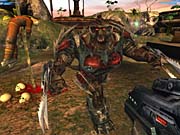
To be sure, Unreal II doesn't follow closely in the footsteps of the original game. Unreal looked great, but gameplay expectations for shooters have changed in the past five years, and as Epic's Cliff Bleszinski himself will admit, the game was too long. Unreal II has the excellent graphics you'd expect from an Unreal game, and it's more or less based on the same engine as Unreal Tournament 2003. But the noncompetitive nature of an exclusively single-player game made it easier for the designers to take the visuals up a notch further than the multiplayer franchise. To be absolutely clear, it's true that Unreal II doesn't have any multiplayer support at all. Still, it's easy to see where the three years went when you see Unreal II's environments, both in terms of their composition and their sheer variety. Unreal II is definitely a rare specimen among first-person shooters in that it adopts sci-fi imagery but doesn't adhere too closely too conventions and ends up with a story and setting all its own.
Legend Entertainment may not be a household name, but Epic and Infogrames didn't hand over the Unreal franchise to a young studio. Legend was founded in the late 1980s and focused on the graphical adventure genre for its first decade, working with Infocom alumni and Presto Studios to release a number of adventure games. Legend has always diligently followed industry currents, and it was one of the first to take up the Unreal engine, using it to create the 1999 game Wheel of Time, which was based on Robert Jordan's fantasy setting. Since that time, there've been up to 25 people working on Unreal II at Legend, in addition to the numerous contracted professionals responsible for the music, voice acting, and such.
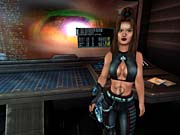
While the game is most definitely about the action you'll see planetside, nearly all 13 of the game's missions begin with an interlude aboard the Atlantis. On the ship, you'll interact with the rest of the ship's four-person crew. The game doesn't hit you with a lot of story exposition all at once, but over the course of the many mission interludes, you will learn more about the crew and the galactic events they get entangled in. The member of Atlantis' motley crew you'll spend the most time interacting with is Aida, the rebellious female intelligence officer in a rather revealing outfit. Isaak is the ship's engineer, and he keeps your arsenal well stocked and upgraded with the latest alien technology. The Terran Colonial Authority's show of diversity comes with Ne'ban, an alien pilot who is often at the center of minor cultural misunderstandings.
The game starts out with the Atlantis docked at a TCA outpost in some backwater section of space, where the main character, Dalton, a former marine, is once again denied permission to return to the military ranks. After completing or refusing the game's tutorial, you'll head out on the game's first mission, which involves heading out in the Atlantis to respond to a distress call. Setting a tone for the game, Dalton turns an investigative jaunt to the planet's surface into a one-man rescue mission.
Put On That Power Armor
Dalton is the sort who probably sleeps in his power armor. But once the action heats up, you'll certainly appreciate the protection that powered armor suit affords him. As an early briefing informs you, Dalton's armor isn't the most advanced, but it is very adaptable, and you'll soon note that it allows for comfortable underwater swimming and isn't too bulky for crawling through tunnels. More than anything, it justifies the terrific amount of damage you can sustain in the face of some fantastically fearsome foes.
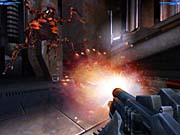
The first few missions aren't an overwhelming challenge, but when you go down to the first planet's surface to single-handedly take on the aliens who cleaned out a mining operation, things get busy real quick. The first aliens you meet are the izarians, which the Legend designers aptly call space monkeys. They wield simple a simple blaster, the shock lance, which wouldn't be too much of a threat were it not for the izarians' tendency to jump out of tunnels behind you and swarm you in groups of three to six.
Pacing and variety seem to have been two core concerns for the Legend designers. Just as you're wondering when the waves of izarians will end, a skaarj warrior makes an appearance (in a notable homage to the first Unreal). Even if the AI for a single skaarj doesn't stump you with its ability to block the assault rifle's uranium rounds with its claws, you may find that a series of skaarj pose more of a challenge. In any case, you can dial the difficulty up or down at any time.
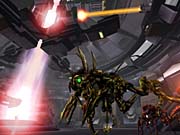
Apart from the return of the skaarj in their new, more muscular form, there are practically no tie-ins with the original Unreal's story or setting. But there are lots of new enemies, and not just a zoo full of aliens. Once you're up to speed, you'll spend a big chunk of the early game facing human enemies--mercenaries who are also rushing to collect a series of ancient alien artifacts initially discovered on the first planet you visited. The two mercenary factions, the Izanagi Corporation and the Liandri Corporation, are well funded, so you can expect their top troops to be nearly as well as equipped as you are. That means they also have relatively slow, heavy troopers in power armor. Fortunately, your arsenal quickly expands to include a rocket launcher, which--in your hands or theirs--cuts through armor in no time.
But just as that armor slows them down, it slows you down. Those familiar with Unreal Tournament and Unreal Tournament 2003 will immediately notice that Unreal II's player movement is quite slow. But whatever your expectation, the slower pacing seems to work, particularly since it's combined with weapons that look, sound, and feel appropriate for a space marine in his full getup. The weapon models are massive, and they're all immediately recognizable. And while the movement may be slower, the combat is furious, often with a good number of enemies--from a handful to a swarm of weaker threats--converging on you at once. There are a few occasions that might make you look for a sprint key, but they seem rare.
Close Combat
There are a number of intense sequences in Unreal II, but some of the most memorable are likely to be the defensive missions. Legend added some strategy to what might have been a series of unlikely one-man standoffs by adding defensive items and the ability to work with squadmates. And establishing a good defense isn't too complicated: There are two types of portable auto turrets that you can set up, and you also have access to field generators that create an energy barrier that soaks up quite a bit of damage. The auto turrets, much like those in the special-edition version of Aliens, are static miniguns that wake up and fire anytime there's an enemy in their limited view cone. To slow down heavier targets, there are also rocket turrets. You'll face both types of turrets yourself, and there are a few tricks to taking them out. First of all, in close quarters, it's feasible to run out of the turrets' view range. Also, there are a couple of weapons--the EMP grenade and the shock lance's alternate fire mode--that cause extensive damage to anything mechanical, including power armor.
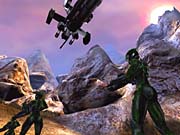
As previously mentioned, there are points where you are briefly put in charge of a small squad of marines. The squad system is exceedingly simple. Walk up to a marine, hit the use key, and assign him or her a point or a series of points to defend. The marines acquit themselves pretty well in battle, but get ready to lose some. There isn't an option to reassign them on the fly. Legend chose to make you talk to squadmates up close and personal, with the idea that it would heighten the suspense when sending a marine out to patrol the perimeter.
The sheer variety of weapons is one of Unreal II's strengths, so it's worth getting familiar with them all. Here's a quick rundown.
Dispersion Pistol: Of course, the basic pistol is often more flash than substance, and this is no different. If you have ammo for something else, use it, although the secondary fire mode charges up for a blast powerful enough to violently shake the weapon on the screen.
Assault Rifle: This rifle has the punch and the extremely high rate of fire to take down any smaller or lightly armored targets in your way. The alternate firing mode fires a single volley of uranium shards that's quite powerful, and the shards can even bounce off surfaces and hit enemies behind cover.
Shock Lance: This blaster weapon you pick up off the izarians seems basic until Isaak modifies it a little to up the power. The secondary fire mode is an EMP blast that can really come in handy for taking out turrets.
Shotgun: You really don't want to get in the way of this auto shotgun. It causes a ton of damage in close quarters, and even though its rate of fire isn't that fast, it doesn't need to be reloaded too often. Even better is its secondary fire mode, which launches explosive rounds that set targets on fire.
More Weapons
Rocket Launcher: This isn't just any rocket launcher. While the main fire mode pretty much does what you'd expect--fire a single powerful blast--the alternate fire mode is surprisingly cool. Initially, the secondary fire mode just launches four swarming missiles that may or may not do anything more than look cool. But Isaak soon upgrades the weapon so each of the four rockets can lock on to a target. All you have to do is hold down the secondary fire key with the reticle over the enemies you'd like to target enemies and then stand back and let them fly. The rockets have little trouble finding targets that have moved behind cover, and it's easy to send all four to one unfortunate individual, if you so choose.
Flamethrower: Look out for the pretty flames. The industrial-sized flamethrower spews out a large billow of ignited napalm, or it can be used to lay down liquid napalm in the alternate mode. Trails of liquid napalm can be set off by any flame and can be used to create traps for enemies.
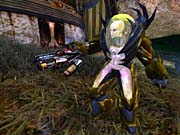
Grenade launcher: This thing looks heavy, and it's massive for a reason: The grenade launcher can pack up to six different types of grenades that can be set to a timed explosion or to go off on contact. The secondary fire button cycles forward through the grenade ammo types: frag, incendiary, EMP, toxic, smoke, and concussion. Among the less self-explanatory types, the concussion explodes in a rather large shock wave that knocks enemies down, and the EMP takes out turrets with a much stronger blast than the shock lance's secondary fire.
Magnum Pistol: Aida loans you this powerful pistol. It doesn't hold a lot of ammo, but what you do get packs a wallop.
Sniper Rifle: Pretty much what you'd expect, until you turn the mouse wheel and dial the zoom all the way up. It makes the other side of a giant level look like it's next door. The impact is good for single-shot takedowns, except when armor comes into play.
Spider Gun: Isaak's own unique invention, this gun harnesses a mutant spider's reproductive gland to launch a bunch of harmful spiders at an enemy, who tends to get pretty distracted by the beasties. The alternate fire mode is a good defense: It either drops a sac of spiders that jump out at enemies who approach or--if you hold the button down--drops a large spider that will fight for you autonomously.
Drakk Laser Gun: Think railgun, plus an additional nasty plasma attack. To reload, you actually feed a little Drakk--a late-game mechanical alien--into the breach.
Takkra: This floating ball is your own personal battle drone. The main attack will send it after enemies, while the alternate mode sets one or more takkra on guard around you, and they'll shoot down projectiles, including bullets, that are heading your way. Don't expect to find many of these, but they should provide a strong defense against many enemies.
Graphics and Gameplay
Unreal II's environments vary quite a bit from mission to mission. Most of the game's 13 missions will take you to nearly as many planets, and these missions are broken up into numerous levels that generally don't take long to load. The level transitions often change the pace of the missions. The level progression features a good mix of traditional shooter fare: plenty of combat, some moody ambiance scenes and exploration, some button hunting, and the rare bit of jumping.
As often happens, the early buzz for Unreal II centered on the game's cutting-edge graphics, but the games obviously has a lot more going for it than eye candy. Even though there've been plenty of great-looking PC games this year, including Unreal Tournament 2003, Unreal II still has all the whiz-bang technical features you could ask for, plus some pretty good art.
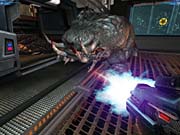
Legend has put a lot of time into Unreal II's graphics, and it has chased the shifting technology curve to include all the new Unreal engine tweaks shown at last spring's GDC, including rag-doll physics and rippling water. There are a bunch of places where Legend has added cool-looking surfaces to objects--shiny and otherwise--that look best on a DirectX 8 graphics card. It's recommended to have a GeForce3 or better and a 1.2GHz processor, although the game will run on somewhat less. Some of the game's most unique graphics effects are the result of a custom particle system Legend has added to Epic's engine. The most stunning evidence of this comes in the form of the smoke that billows out of smoke grenades. The smoke doesn't just hang there like a static fog. Instead, a nearby explosion--and particularly a concussion grenade--will have the natural effect of blowing it in the opposite direction, as it swirls and billows.
While we had the chance to play through many of the game's missions, we couldn't linger over every nook and cranny of Unreal II's many planets. But what we did see of the game's many worlds showed a lot of polish. Not least important is the use of ambient audio to create a creepy mood where appropriate. Visually, an alien swamp and other outdoor areas have indigenous life-forms walking around, many of which are mainly harmless window dressing. Some of the later worlds and creatures stand out creatively, not only within the game, but also as some fairly distinguished sci-fi creations.
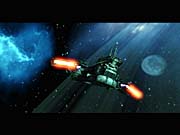
Unreal II is complete in terms of content and features, but clearly, the game isn't done quite yet. A Legend designer recognized that many new players had trouble finding one or two of the early switches that appear before most players get a good sense of the design style, and he said that should be addressed. Otherwise, Legend will spend the next couple of months fixing bugs and optimizing the code, and the plan is to have the game ready in late January.
One year ago, Legend decided it couldn't deliver a game with both single-player and multiplayer components that met its expectations. That's why Digital Extremes and Epic split Unreal Tournament 2003 off from the Xbox work in progress, Unreal Championship. No matter how promising it looks, Unreal II will have its critics as a linear, exclusively single-player game. Certainly, it would be interesting to see these weapons in a multiplayer game. For those who just want to know how long it is, for now we'll just have to trust the designers' word: 15 to 20 hours. It won't be too long before we can see for ourselves.
Got a news tip or want to contact us directly? Email news@gamespot.com
Join the conversation